MARIANI’S
Virtual
Gourmet
December
23, 2018
NEWSLETTER

❖❖❖
IN THIS ISSUE
ST. LOUIS EATS
By John Mariani
NEW YORK CORNER
ZAVŌ
By John Mariani
NOTES FROM THE WINE CELLAR
WONDERFUL WINES AND SPIRITS
FOR CHRISTMAS DINNER
By John Mariani
❖❖❖
ST. LOUIS EATS
By John Mariani
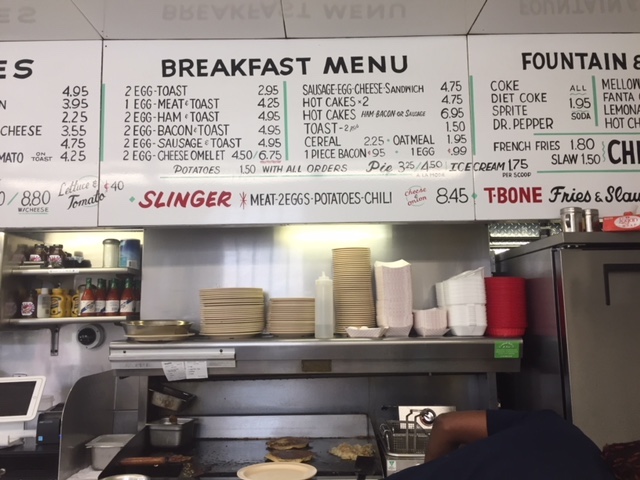
EAT-RITE DINER
Danny Meyer, owner of New York’s
Union Square
Café and Gramercy Tavern and the Shake Shack
chain, says he bases his ideas of
hospitality on his memories of his hometown of
St. Louis, explaining, “When
I think about what St. Louis gave me, it gave
me everything I am in terms of
understanding that a restaurant, at its best,
can make people feel better than
when they came in."
Visitors to St.
Louis will feel that same vibe eating around town,
on the high end at places
like Tony’s or at the eateries, pizzerias,
barbecues, cafés, diners and burger
joints spread throughout the city. I certainly
felt it on a trip this fall,
when I found no fault with the hospitality and a
whole lot of goodness in the
food.
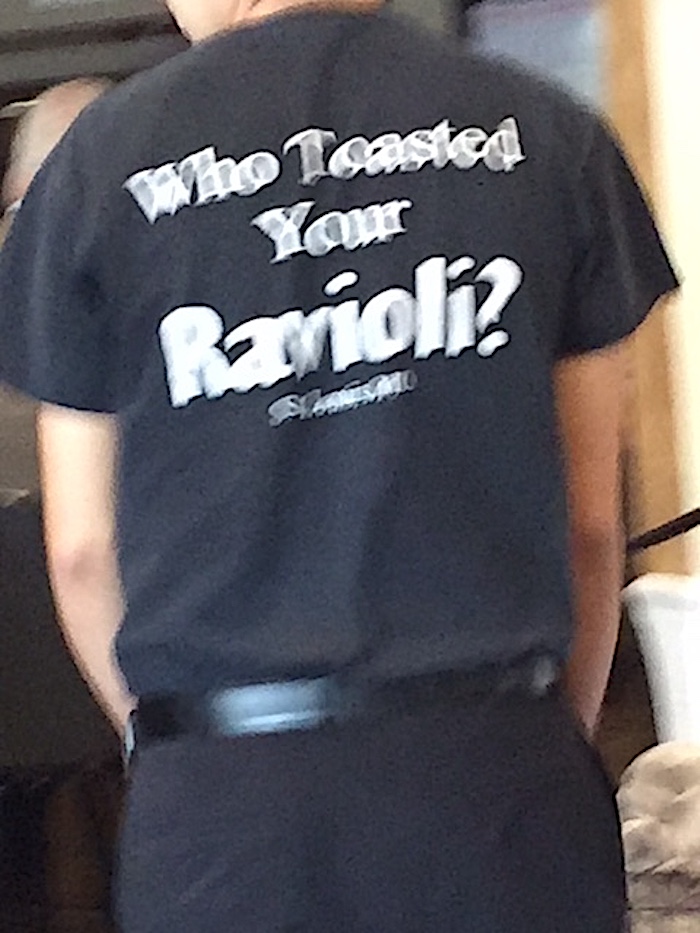 MAMA’S
ON THE HILL
MAMA’S
ON THE HILL
2132
Edwards Street
314-776-3100
The Hill is St. Louis’s Little
Italy, and while
the streets are not jammed with tourists, this is
where you’ll find the totemic
Italian-American restaurants of the Midwest, not
least Mama’s on the Hill,
which has been around for a century, originally
called Oldani’s. The Campisi
family ran it as of 1985, gave it its current
name, and since 2005 it’s been
run by Lance and Andrea Ervin. I guess 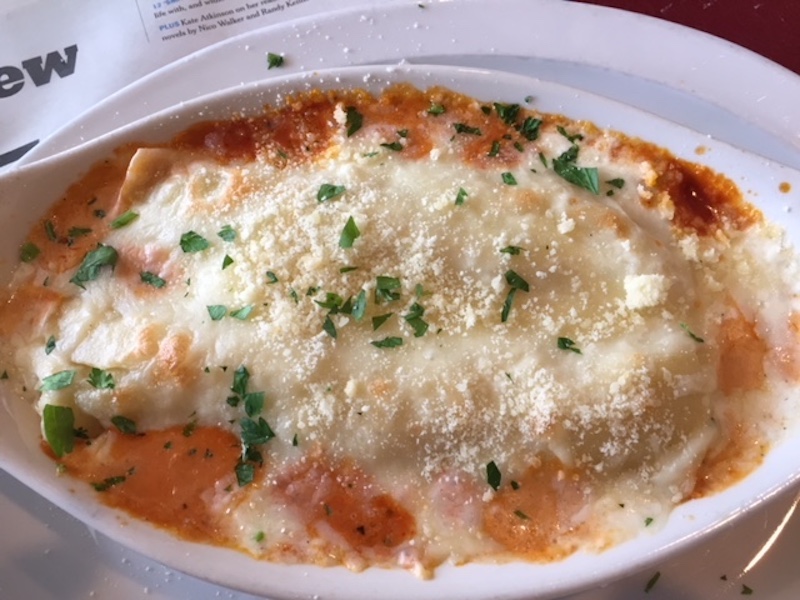 you’d call Mama’s a
cultural fixture in
town.
you’d call Mama’s a
cultural fixture in
town.
Mama’s looks like you’d hope a
family
Italian-American restaurant should look—archways,
simple furniture and
chairs—and the menu is huge. Of course, everyone
orders the toasted ravioli
($7.25). The claim is that a chef named Fritz, who
worked at an earlier
restaurant on the site, created toasted ravioli by
accident (these stories
always include “by accident”) when he dropped
ravioli into a deep fryer and
they came out looking toasted. Now, it’s a classic
St. Louis item, both on The
Hill and all over the city.
I stopped
by for lunch on a Sunday, when most
of the other restaurants on The Hill are closed.
The aroma of good cooking
drifted outside onto the street and I was hooked.
I was amiably greeted in the
front room (among several) and handed a vast menu
of every Italian-American
dish you could wish for. The waiters wear black
signature t-shirts. Sinatra and
Sam Cooke were singing in the background.
The garlic cheese bread ($4.95)
was good. The
lightly battered eggplant parmigiana ($10.95)—as a
starter, enough for four
people—was very good. And the
cannelloni ($10.59), stuffed with a very creamy
mix of beef, pork and veal,
lavished with Parmesan and a first-rate marinara
sauce, all baked in a
casserole, could not have been better or more soul
satisfying (above).
The cannolli, a
little grainy, need work and the wine list is not
exactly in the vanguard of
Italian viniculture. But I
wouldn’t change much about Mama’s. It’s just what
you hope it will be and it’s
just wonderful.
Open for lunch and dinner daily.
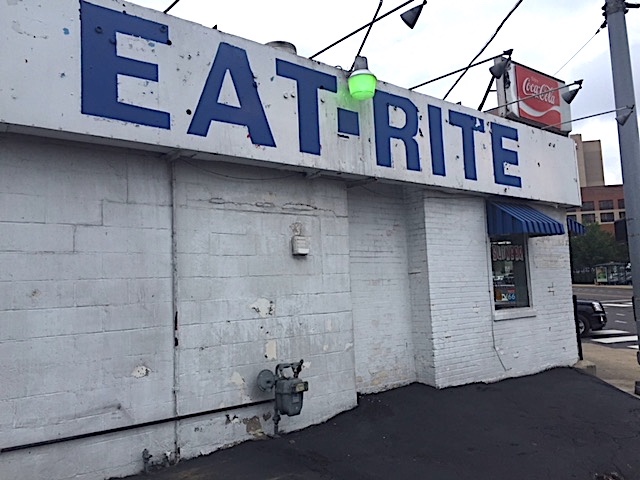 EAT-RITE
DINER
EAT-RITE
DINER
622
Chouteau Avenue
314-621-921
Re-opened this past year by Joel
and Shawna
Holtman, after its closing by 80-year-old owner
L.B. Powers, Eat-Rite doesn’t
look like much from the street, but once inside
you may think you’re looking at
a Smithsonian tableau of 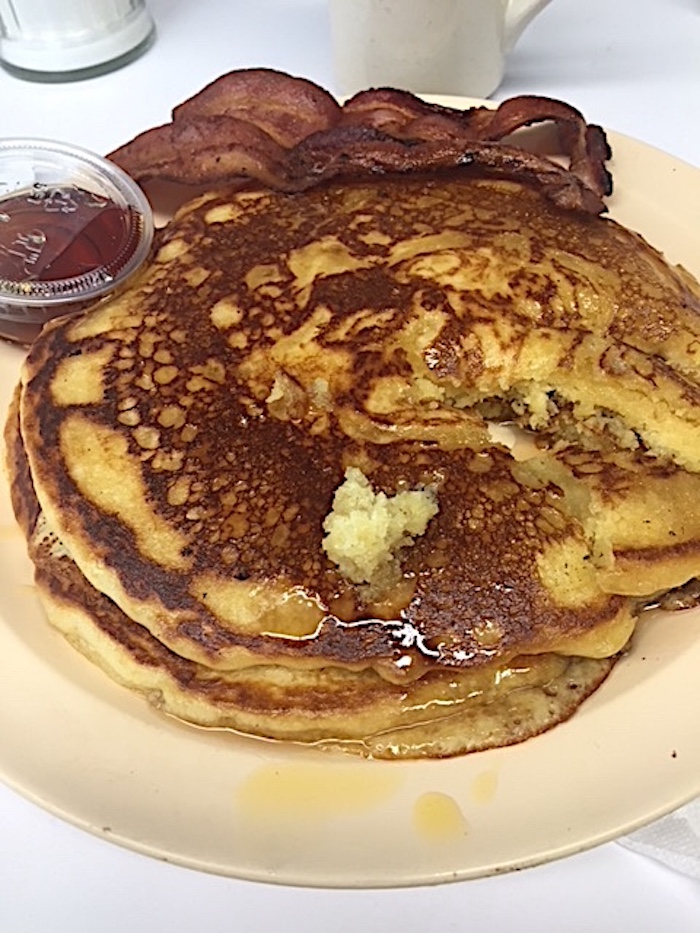 an
American down-home roadside restaurant. For that
alone it’s worth an archaeological peek for the
spanking white tiles and
countertop, lipstick red stools, all new kitchen
equipment and a menu sign
whose prices seem a throwback to the 1960s. It is
an embodiment of Gastro
Americana, Midwest Division.
an
American down-home roadside restaurant. For that
alone it’s worth an archaeological peek for the
spanking white tiles and
countertop, lipstick red stools, all new kitchen
equipment and a menu sign
whose prices seem a throwback to the 1960s. It is
an embodiment of Gastro
Americana, Midwest Division.
The burgers are now made from
fresh, not
frozen, meat, the thick fruit pies made every
morning, and the signature item
called the “slinger” (on the menu
since 1985), a platter of burger or sausage meat
or bacon with eggs and
potatoes covered with chili sauce, American cheese
and raw yellow onions
($8.45) hasn’t changed at all.
I dropped by for breakfast, and
after the grill
cook with long fake eyelashes sized me up, she
made me the best, biggest
pancakes I’ve had in a long while—perfect rounds
perfectly browned, true hot
cakes, filling the plate, with admirably crisp
bacon. (Okay, it would be
better if they served real maple syrup.) The
remarkable thing
about them was their puffy lightness, unlike so
many leaden versions you find
elsewhere.
Why
anyone in St. Louis would go for a
belly-busting gorge at IHop when they have
Eat-Rite is beyond me. And do have a
slice of pie.
Open all day every day.
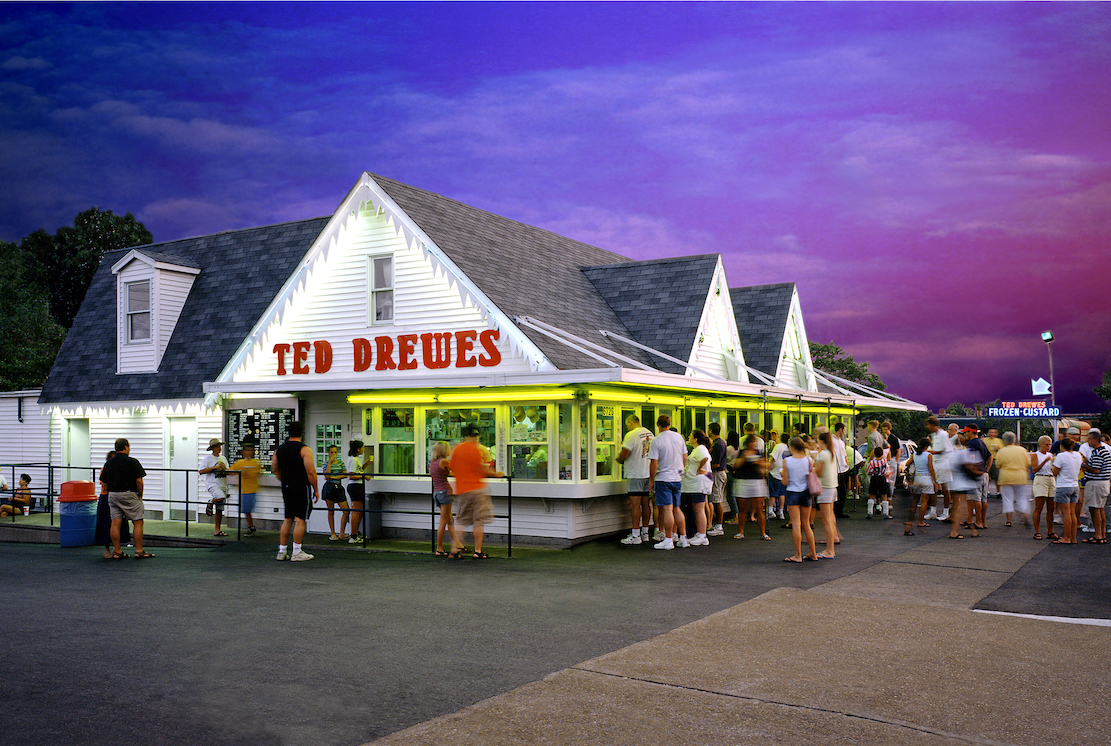 TED
DREWES
TED
DREWES
6726
Chippewa Street
312-481-2652
Conjure up some 1950s reverie of
St. Louis in
July—coming out of an air-conditioned movie
theater into a warm, humid night
and dying for some ice cream. You drive your
sedan, top down, along Route
66—and you spot the bright lights of Ted Drewes,
its peaked roof hung with
decorative icicles, a yellow neon strip around the
outside and the twelve
ordering windows with a line of customers
stretched way down the block. You
probably know half the folks on line.
Ted Drewe’s started out in 1930
(the Chippewa
branch in 1941) and became famous for its frozen
custard “concrete,” whose
texture is so thick it’s served upside down. There
are also all the
usual confections from sundaes to shakes.
But that’s not
a reverie. It’s the way it was and still is at Ted
Drewes. In December Ted
Drewes also sells Christmas trees. Had Jean
Shepherd’s A Christmas Story been based in St.
Louis, a scene would have been
filmed there.
Open
daily.
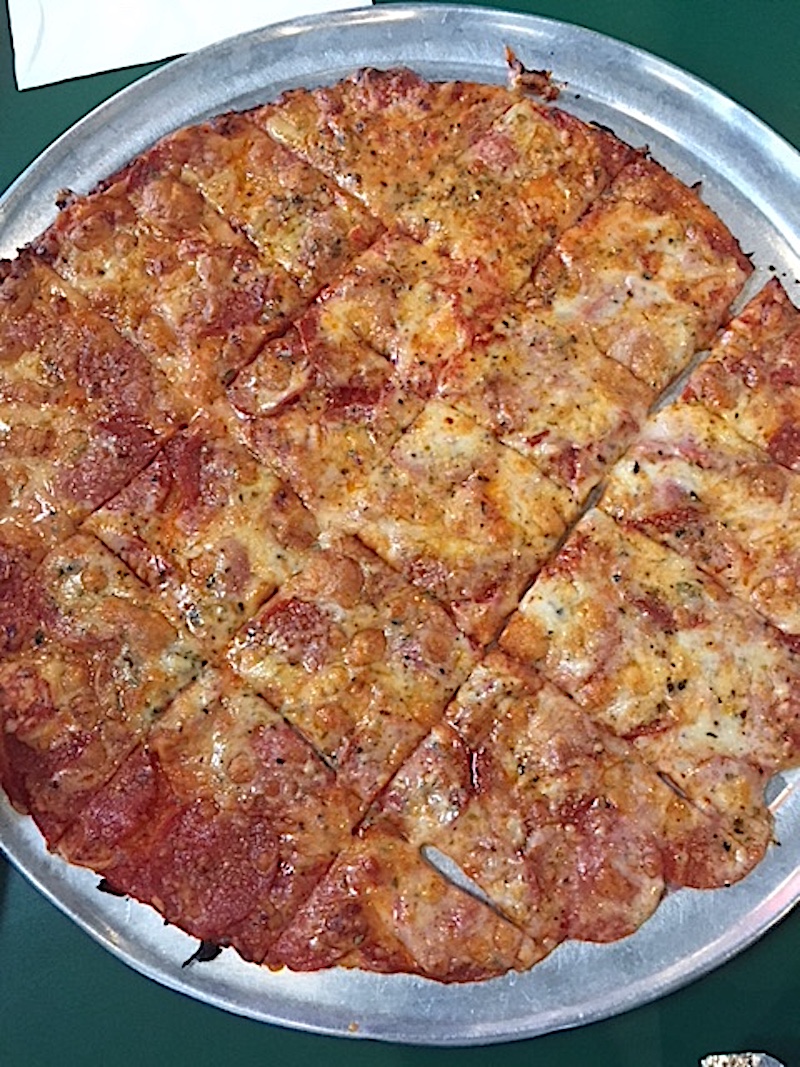
904
South 4th Street
314-421-4667
St. Louis style pizza,
thin-crusted and square
rather than circular, was transformed by Ed and
Margie Imo when they opened
their first pizza parlor in 1964 at Thurman and
Shaw Avenues, using Provel
cheese (cheddar, Swiss and provolone) instead of
mozzarella. By 1985 they had
30 stores and started franchising; today there are
100 all over Missouri.
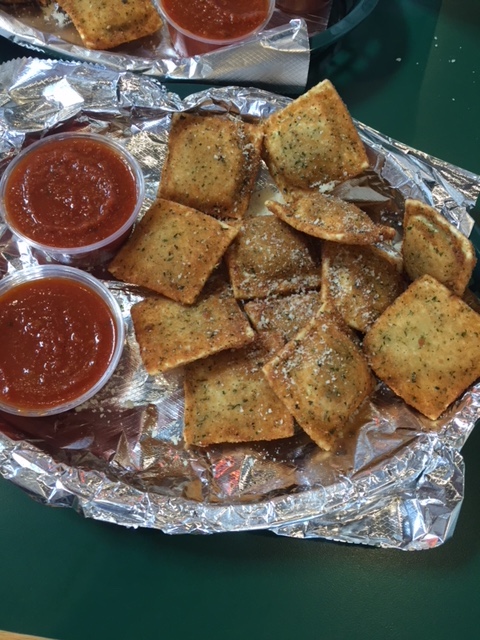 This is the pizza you
want late at night when
you get the munchies, when your kids need to be
quieted down, on a first date
or when the Cardinals lose their fifth straight
game in September.
This is the pizza you
want late at night when
you get the munchies, when your kids need to be
quieted down, on a first date
or when the Cardinals lose their fifth straight
game in September.
It’s a very tasty pizza and you can
put away a lot of slices.
I’m not crazy about the lingering oily aftertaste
of the Provel, but it’s yet
another item you’ve got to try if you spend more
than 24 hours in town.
They also do a good job with
toasted ravioli (left).
Open daily for lunch and dinner.
SALT
+ SMOKE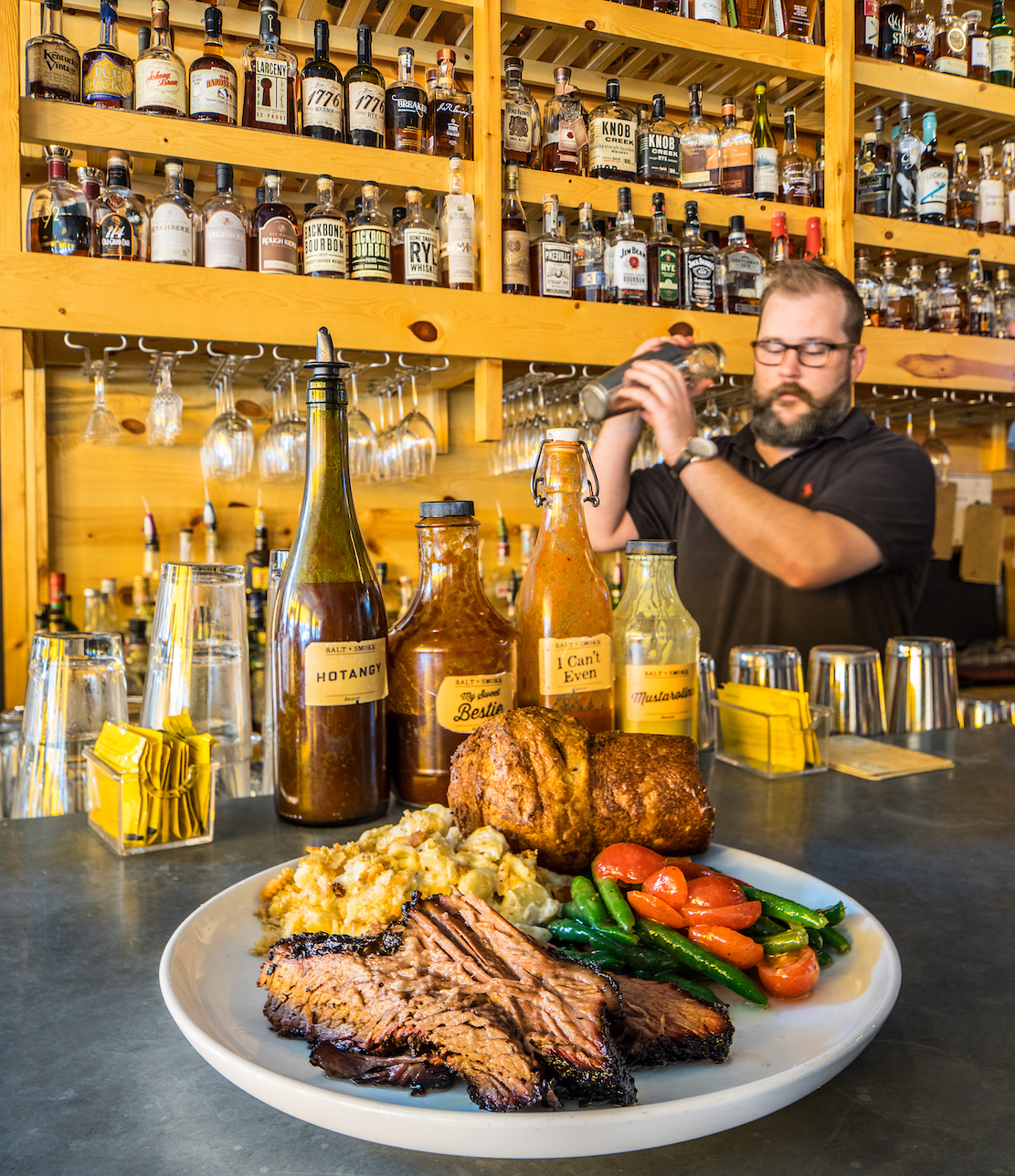
6525
Delmar Boulevard
314-727-0200
The University area in the Delmar
Loop teems
with eateries of every type, and Salt + Smoke is
one of the most popular. It’s
lively but way too loud, with a bar with a
daunting number of bourbons on the
shelves and a lot of house cocktails.
Of course it sells St. Louis
cut ribs ($15.95
to $26.95), along with brisket ($10.95), pulled
pork ($14.95) and fried bologna
with jalapeños and cheddar ($12.95). The creamy,
not gloppy, mac-and-cheese
($5) is a good side, and for an appetizer go for
the crispy hush puppies with
maple butter ($4.95) or the “burnt end toasted
ravi[oli]s ($10.95).” Demerits for dried-out
popovers that
come with most main courses and the way some of
the barbecue comes out barely
warm.
Open
daily for lunch and dinner.
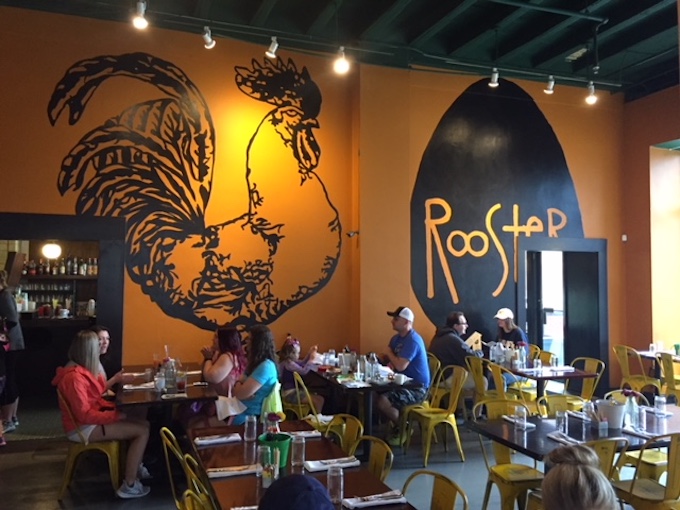 ROOSTER
ROOSTER
1104
Locust Street
314-772-3447
Brunch looms large in St. Louis,
and one of the
most popular places to get it is at Rooster (with
two locations), not least for
its “breakfast beer,” made at the local 4 Hands
Brewery. The reception and
waitstaff add at least fifty percent to the  enjoyment level,
portions are very
generous and the place is big, colorful and has
some of the most uncomfortable
metal chairs I’ve ever sat in.
enjoyment level,
portions are very
generous and the place is big, colorful and has
some of the most uncomfortable
metal chairs I’ve ever sat in.
They do a slinger (right) made
with andouille sausage
over a light, feathery biscuit
($10), and it’s terrific, with all kinds of
flavors and textures
coalescing nicely.
The crȇpes ($9
to $11) are a best seller for all the right
reasons, from the delicate
lightness of the crȇpe to the fresh fillings that
range from German sausage to marinated
spicy chicken and smoked sirloin, as well as sweet
versions ($5 to $6) of
chocolate chip, Nutella, s’mores and roasted
apples.
Open daily for breakfast, lunch and dinner.
By John Mariani
1011
3rd Avenue (near 61st
Street)
212-753-5500
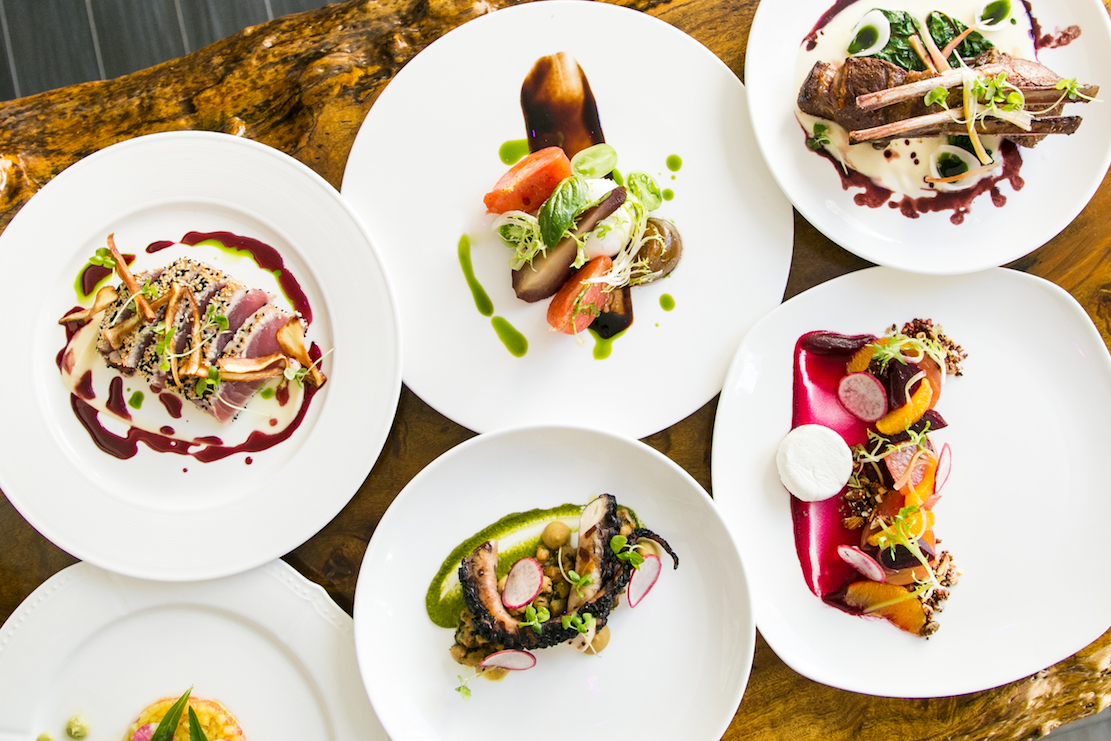
Even jaded New Yorkers can use
a little Vegas
pizzazz now and then, and Zavō, founded by
Ilya Zavolunov, has some of the same
vibe as you might find in one of the casino
restaurants in Nevada. At least on
weekends, when it changes to a nightclub.
Largely, it is set upstairs
for catered
affairs, something Zavōlunov is known for as
owner of the Da Mikele
Illagio catering venues in Queens.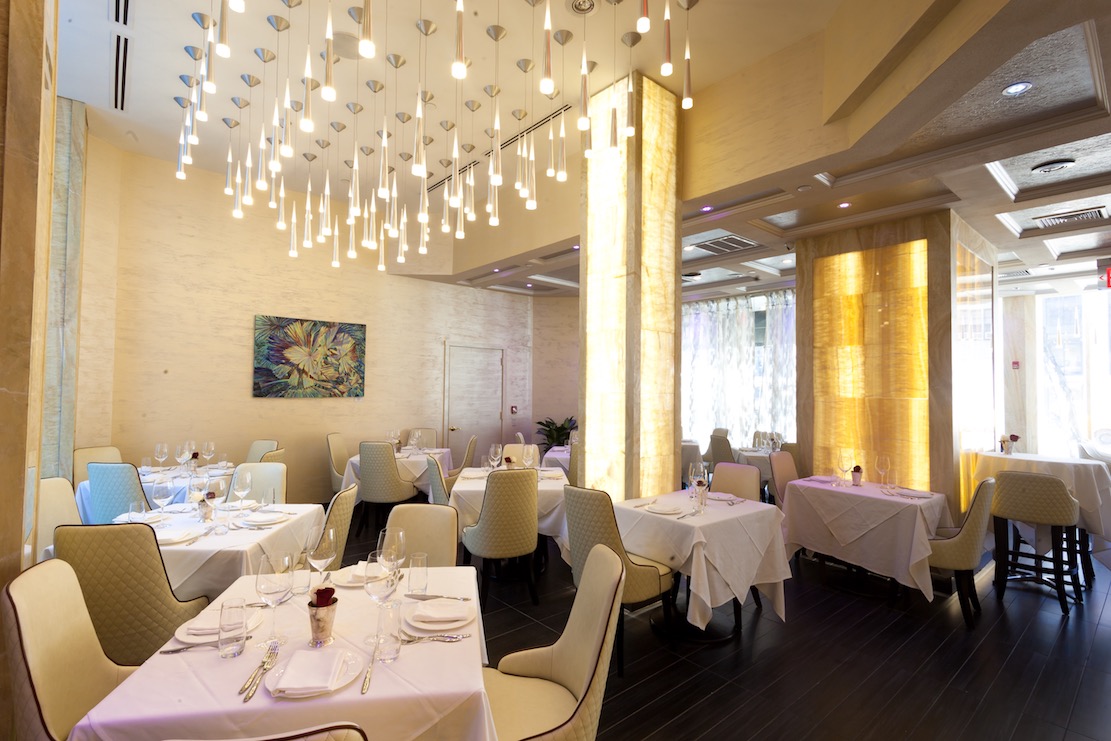 His
family hails from Uzbekistan, moved
to Austria and traveled throughout the Eastern
Mediterranean to hone skills you
see represented on the menu at Zavō.
His
family hails from Uzbekistan, moved
to Austria and traveled throughout the Eastern
Mediterranean to hone skills you
see represented on the menu at Zavō.
Lively on weekends, the
downstairs dining room
can be a bit lonely on weekday nights.
We dined at Zavō on a Monday and it was
nearly empty. Still, Zavōlunov
and his staff showed a welcoming flair for
service that warmed the evening up
considerably.
The room is very spacious,
with tables widely
separated. Columns of light extend to a tall
ceiling, itself set with lights
that look like falling comets. Walls are
textured in the color of Champagne,
and the white bar shimmers with light and is set
with flowers. Tables are well
set with napery and stemware, and the chairs
exceptionally comfortable.
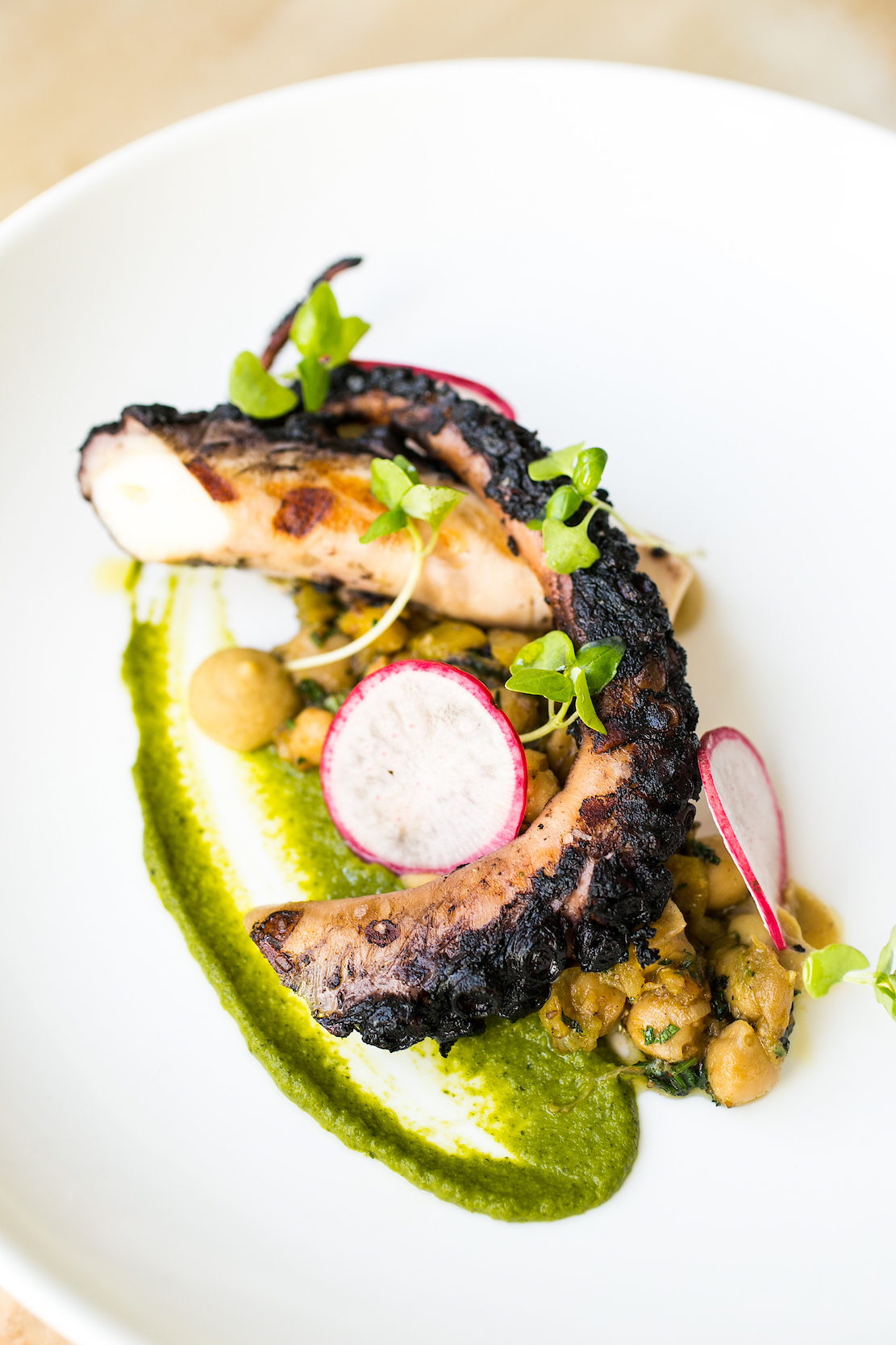 The
evening à la carte menu begins with grilled
asparagus generously dressed with bacon lardons,
a sunny side up egg and a basil
pesto ($8),
and the chargrilled octopus with hummus, cilantro aïoli and
a little mango ($14) succeeds in
the way the flavors of the sea and the fruit
meld (left).
The crabcake has a
commendable amount of jumbo meat, with a romesco
sauce and apple-celery slaw,
all at a very modest price of $10.
The onion rings ($9) are cut thick and
cooked golden and crispy, sweet
and tangy, with a splash of vodka in the batter
and a paprika aioli; and they
work as an appetizer for the table.
Complementary flavors of creamy avocado, a
soy-lime ponzu and a hint of wasabi bring out
the freshness of a tuna tartare
($19). My favorite starter that night was a rich
lentil soup ($10), ideal for
cold weather, flavored with celery, carrots,
fennel and laced with sour cream.
The
evening à la carte menu begins with grilled
asparagus generously dressed with bacon lardons,
a sunny side up egg and a basil
pesto ($8),
and the chargrilled octopus with hummus, cilantro aïoli and
a little mango ($14) succeeds in
the way the flavors of the sea and the fruit
meld (left).
The crabcake has a
commendable amount of jumbo meat, with a romesco
sauce and apple-celery slaw,
all at a very modest price of $10.
The onion rings ($9) are cut thick and
cooked golden and crispy, sweet
and tangy, with a splash of vodka in the batter
and a paprika aioli; and they
work as an appetizer for the table.
Complementary flavors of creamy avocado, a
soy-lime ponzu and a hint of wasabi bring out
the freshness of a tuna tartare
($19). My favorite starter that night was a rich
lentil soup ($10), ideal for
cold weather, flavored with celery, carrots,
fennel and laced with sour cream.
Prices
for main courses are not as modest, with
pasta $25-$41 (for fettuccine and lobster). But a roasted
Mediterranean sea bass at $32 with zucchini,
squash, peas and a Fresno pepper vinaigrette was
as finely wrought as any I’ve
had this season, and lamb chops ($38) were hefty
and delicious, served with a
butter-rich puree, cipollini, sautéed spinach
and the reduced juices from the
lamb.
If you are in the mood for a
simple chicken
dish deftly cooked, I highly recommend 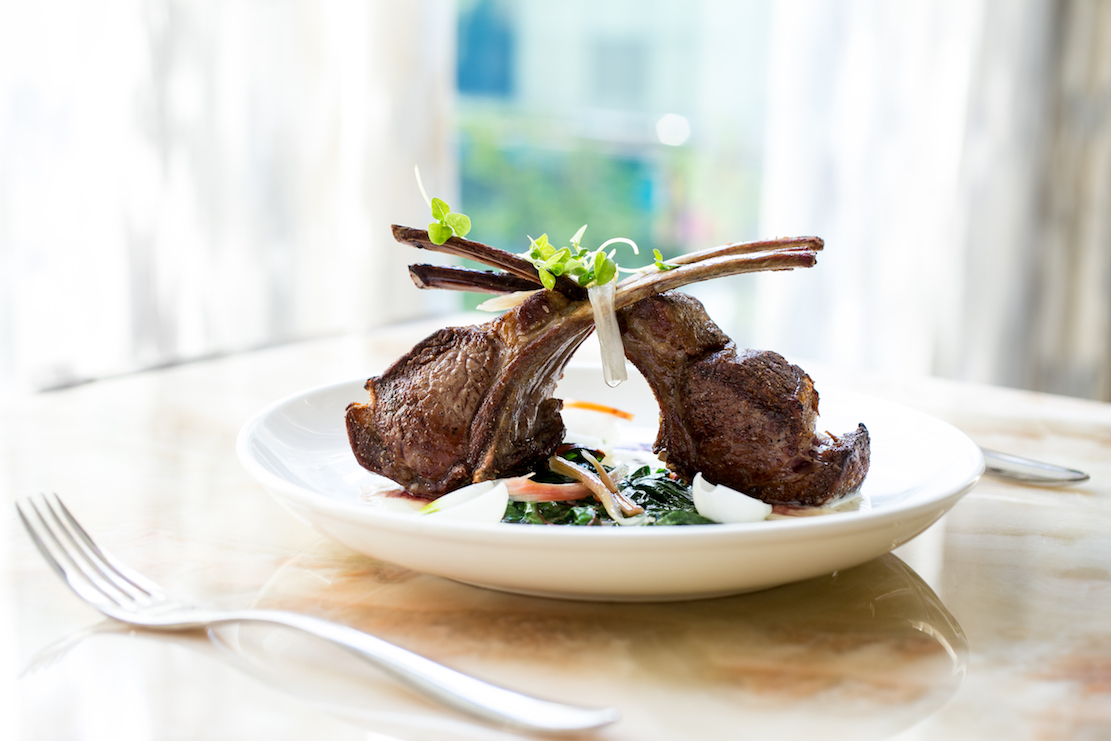 the brick-pressed
chicken with a nice, crispy
skin, fingerling potatoes, string beans, braised
fennel and a lovely rosemary jus
($32), again in a generous portion.
For a side dish, the roasted Brussels sprouts
with toasted almonds ($9) was a
good choice. Desserts were not
out of the ordinary but well
made, as can be the case with caterers who have
so much nightly experience
making them. The New York style cheesecake
($10), citrus crème brûlée with
berries and mint ($10), “Death by
Chocolate” cake ($13) and pistachio baklava with
apples and pistachio ice cream
($12) were all of good quality.
the brick-pressed
chicken with a nice, crispy
skin, fingerling potatoes, string beans, braised
fennel and a lovely rosemary jus
($32), again in a generous portion.
For a side dish, the roasted Brussels sprouts
with toasted almonds ($9) was a
good choice. Desserts were not
out of the ordinary but well
made, as can be the case with caterers who have
so much nightly experience
making them. The New York style cheesecake
($10), citrus crème brûlée with
berries and mint ($10), “Death by
Chocolate” cake ($13) and pistachio baklava with
apples and pistachio ice cream
($12) were all of good quality.
Wines by the glass ($12-$16)
are mostly well
known labels, while the wine list has three
dozen Champagnes (none bargains),
and the Bordeaux,
Cabernet
Sauvignon and Italian selections
are impressive in their depth, though with high
mark-ups. For instance, a
simple Travaglini Gattinara 2012 sells for about
$29 in the store; here it’s
$100.
For a
quiet night with friends, wives, husbands
or business associates, where conversation is
highly desirable, Zavō functions
well in midtown—it’s just a block from
Bloomingdale’s, lunch is fixed at $25.99
—as a good choice. On weekends,
it kicks into more of a Vegas vibe.
Open for lunch and dinner daily.
FOR CHRISTMAS DINNER
By John Mariani
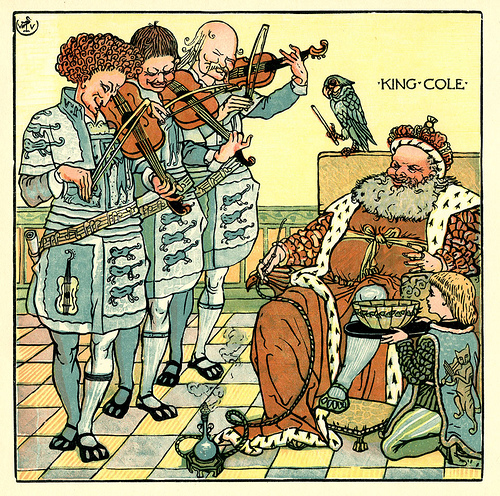
"King Cole" by Walter Crain
Although not everyone is serving the same traditional dishes at Christmas, many Americans will. So here’s a short list tied to what people tend to feast on for Christmas Eve and Christmas.
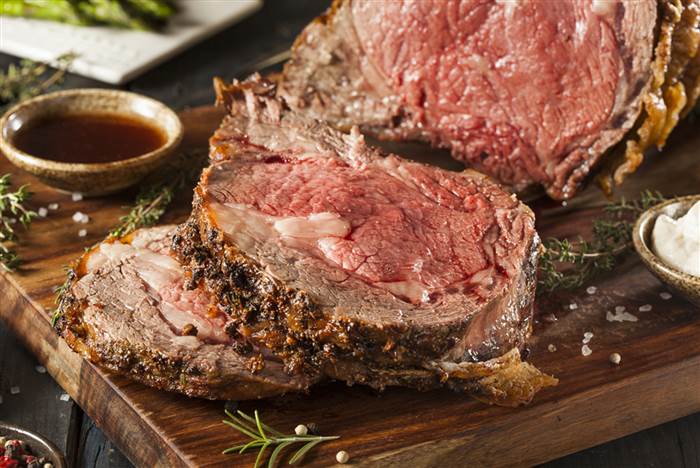 ROAST
BEEF
ROAST
BEEF
Badia a Coltibuono Montebello Toscana 2013 ($60)—With roast beef the classic choice is a full-bodied Bordeaux cru or California blockbuster. But I like a bit more subtlety in the match-up, so I’m going with this Tuscan beauty that is luxuriously velvety beneath the robust opening. The blend is unique: with nine varietals in play: Mammolo, Ciliegiolo, Pugnitello, Colorino, Sanforte, Malvasia Nera, Canaiolo, Foglia Tonda and Sangiovese, each vinified and aged separately in small barrels. It’s more complex than most so-called Super Tuscans for that reason alone.
TURKEY
Jefferson Vineyards Viognier 2016 ($30)—The tendency is often to serve a Pinot Noir with turkey, but I think this splendid Virginia-made 13% alcohol Viognier has all the spice, citrus and levels of flavors that marry well to both the white and dark meat and can handle stuffing and sweet potatoes, too.
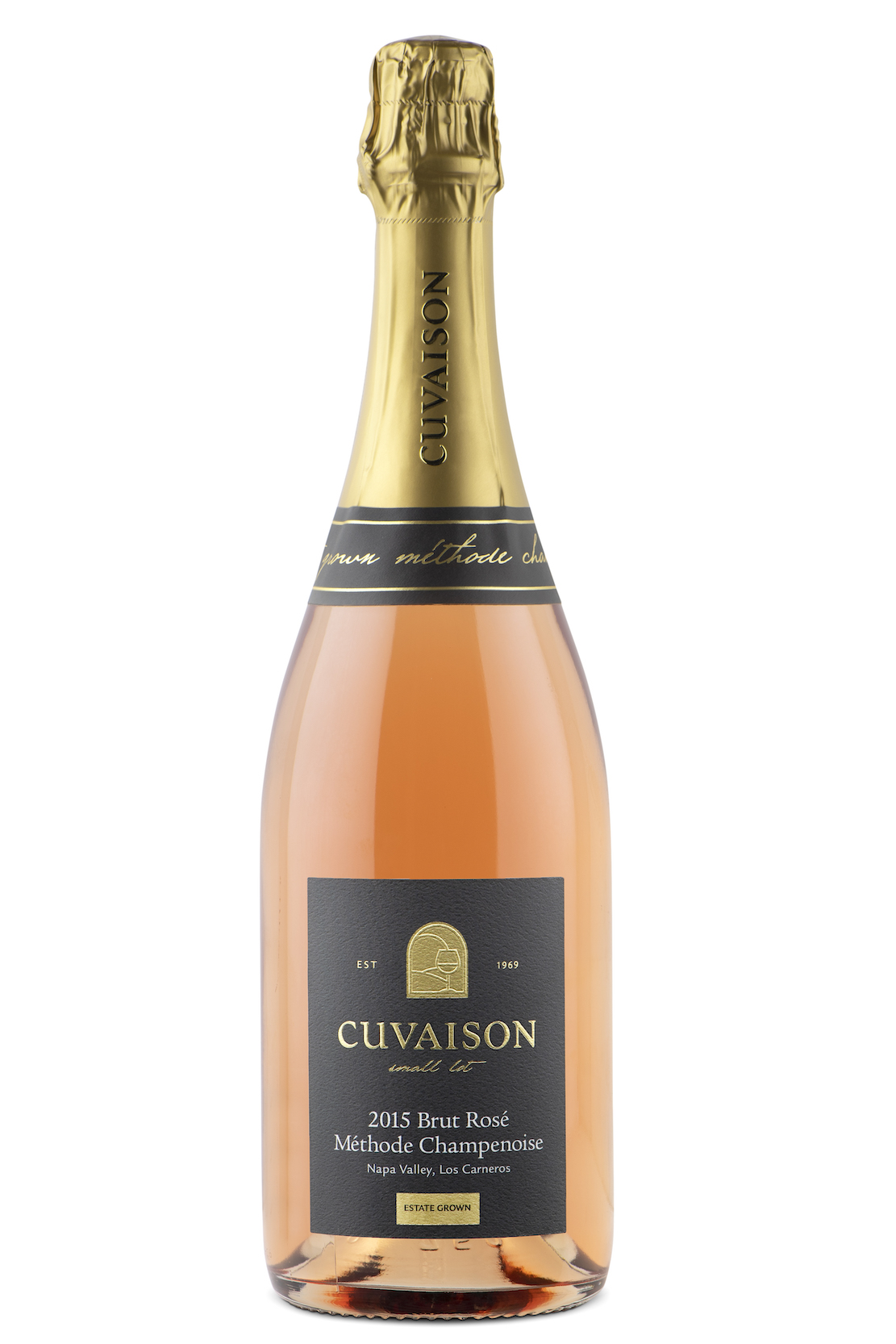 GLAZED
HAM
GLAZED
HAM
Cuvaison Brut Rosé 2015 ($50)—The honeyed sweetness of glazed ham, often with cloves, deserves a sweet touch in what you drink and Cuvaison’s Napa Valley rosé sparkling wine has that and a fizz that helps temper the richness of the meat. The wine is made from 60% Chardonnay and 40% Pinot Noir and is aged two years on the lees to give it some heft.
ROAST GOOSE OR DUCK
Graziano Zinfandel 2014 ($19)—Zinfandel has those deep, dark fruit flavors and tannins along with a subtle sweetness that is perfect with well-fatted roast goose or duck, especially if some fruit like apples or oranges are served alongside. This bottling is from Mendocino, with a high alcohol volume of 15.9% that edges toward being somewhat Port-like. The blend is 90% Zinfandel, 8% Petite Syrah and 2% Carignane.
SEAFOOD
Berne Inspiration 2017 ($20)—Many Mediterranean cultures serve seafood on Christmas Eve, including the Italian La Vigilia that dictates seven fishes be served. This lovely and well-packaged rosé from the Côtes de Provence is made from 70% Grenache, 20% Cinsault and 10% Syrah, this last giving it a bit more body to go with any spices like fennel and garlic used with the seafood. The aromatics of lavender and rose are perfect for a soup like bouillabaisse, too.
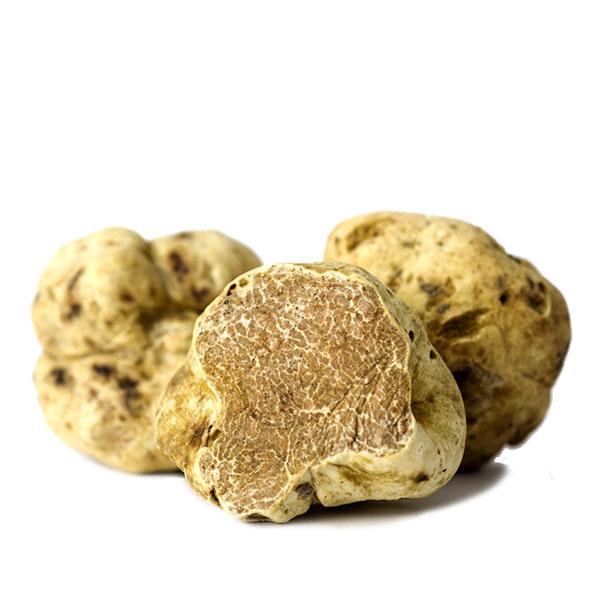 PASTA WITH WHITE TRUFFLES
PASTA WITH WHITE TRUFFLES
Charles Heidsieck Rosé Réserve Champagne ($80)—If you’re splurging on black or white truffles on buttered pasta this Christmas, you might as well match such largess with a great Champagne. The delicate flavor of truffles is too often compromised by big reds (including Nebbiolos from Piedmont, where white truffles come from). Champagne of this caliber has the body and richness to maximize the truffles’ own taste and deal with the richness of the butter. The blend has 20% reserve wines aged at least ten years in the bottle, which adds to its complexity.
CHEESE COURSE
Ramey Rochioli Vineyard Chardonnay 2015 ($65)—Other than Port or Madeira, I always recommend a refined white Burgundy or big California Chardonnay with cheese. Ramey’s is not too oaky and has lots of satisfying citrus. It’s a lovely wine, reminiscent of Burgundy’s best, yet through-and-through a California wine. Its 14.5% alcohol is not something I’d want to go with seafood, but with cheese, it works beautifully.
CHRISTMAS PUDDING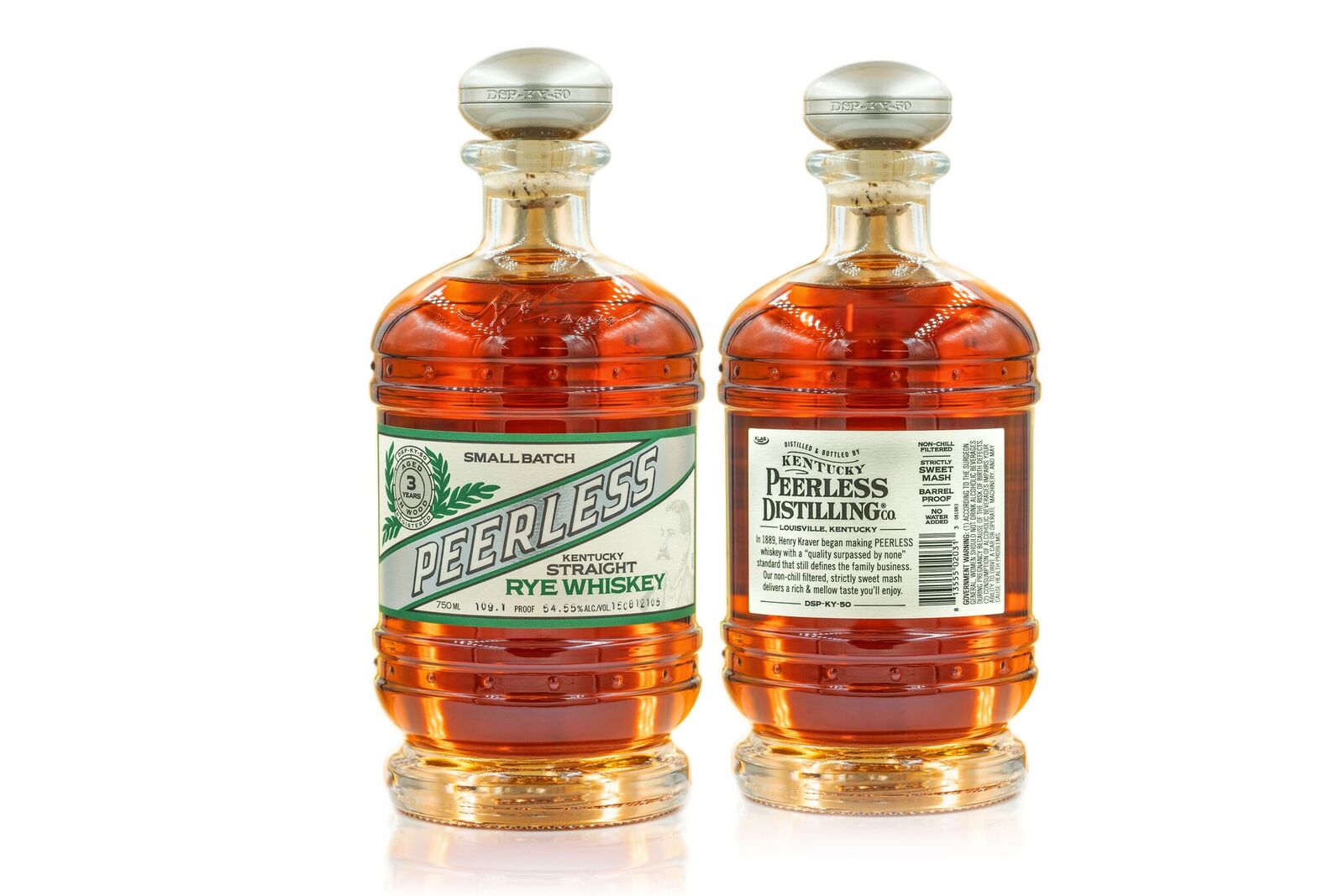
Peerless Kentucky Straight Rye Whiskey ($120)— Whiskey, rather than a sweet dessert wine, goes better with this always very sweet confection, and it’s good to see how wonderful new rye whiskeys are coming to market. Peerless first made this one back in 1889 but brought it back this year as a straight, uncut 55% alcohol Kentucky strictly sweet mash version, with only 80 cases made. It also comes in a festive bottle that’s nice to show for the holidays.
PUMPKIN PIE
Wild Turkey Spiced Bourbon ($22)—I am no a big fan of spiced rums generally, but since pumpkin pie is a mélange of wintry spices, this 86-proof bourbon from Wild Turkey makes perfect sense. The proof is higher than that of cheaper flavored bourbons, and it’s made from straight whiskey. The vanilla component is so good with bourbon, and this would make a fine addition to coffee at evening’s end.
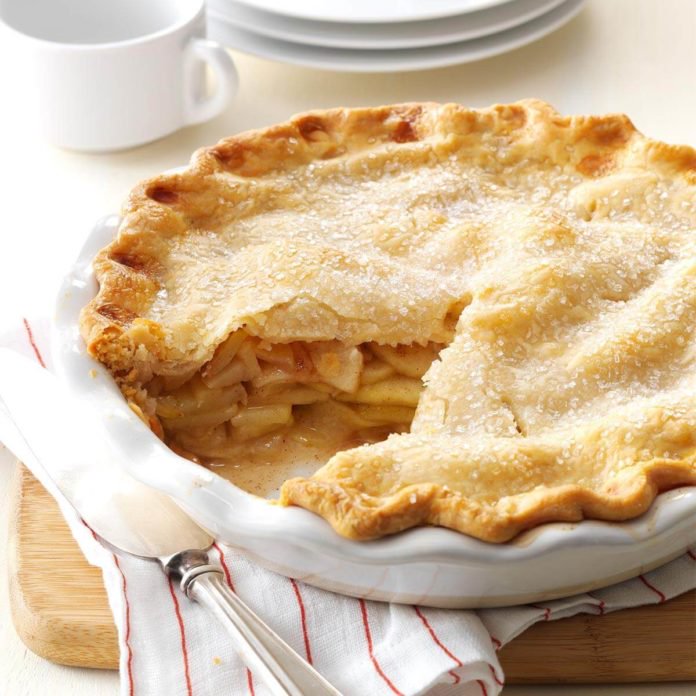 APPLE PIE
APPLE PIE
Mi Campo Reposado Tequila ($20)—True, tequila is not something that leaps to mind with apple pie, but what it adds are multiple, additional flavors. Made from 100% blue agave, this reposado (aged, unlike a bland blanco) is based on piñas that are squeezed, not crushed, as is common, then double distilled and aged for three months in French oak wine barrels to add flavors. It’s even a good idea to put a little salt on the rim of the glass, which will perk up the caramel flavors of the baked apples.
CHESTNUTS
Kopke 30 Years Old
White
Porto ($90)—Red Port is terrific with
roasted nuts but I like  the alternative of
an aged white Port with chestnuts.
Made from Arinto,
Viosinho, Gouveio, Malvasia Fina, it has
complexity and refinement, not too sweet, not
at all cloying, a perfect foil
for the smokiness of the chestnuts.
the alternative of
an aged white Port with chestnuts.
Made from Arinto,
Viosinho, Gouveio, Malvasia Fina, it has
complexity and refinement, not too sweet, not
at all cloying, a perfect foil
for the smokiness of the chestnuts.
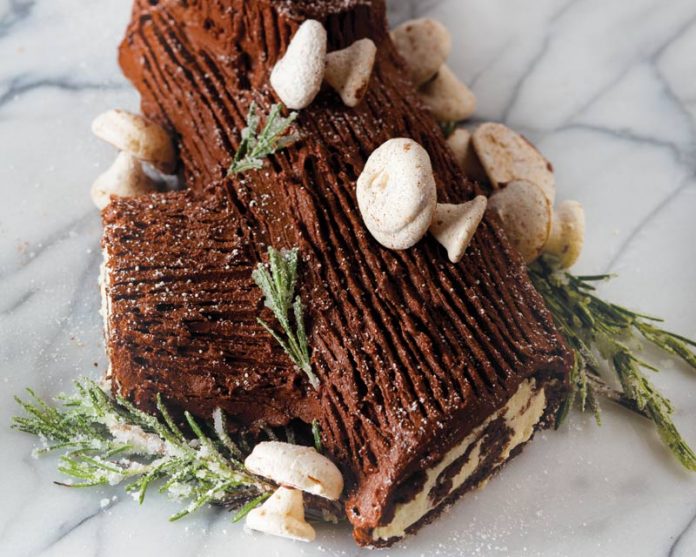 YULE LOG
YULE LOG
Château du Tariquet VSOP ($100)—A Yule log. or bûche de noél, is as decadent a chocolate dessert as one might wish for at the end of a Christmas dinner, so you should drink a decadent wine or spirit to go with it. Even the sweetest Sauternes aren’t sweet enough to battle with dark chocolate, so I recommend a fine Armagnac, which has a little rougher character than Cognac, though distilled from the same grapes— Folle Blanche, Ugni Blanc and Colombard. The components of various years’ brandies, with the average aged in oak for seven years, provides aromas of yeast and candied fruit, without being sweet.
 WATERCRESS AND SEAFOOD
TO
WATERCRESS AND SEAFOOD
TO
MAKE BIG COMEBACK IN 2019!
Chef Battle, a national cooking
competition tournament series produced by Social Power Hour in Lake
Forest. CA,, released its
2019 food trends prediction after surveying over
500 chefs from around the United States.
The top 5
2019 food predictions are:
1. Fermentation
2. Plant-Based Foods
3. Watercress
4. Seafood
5. Allergen Safe Foods

Wine
Column Sponsored by Banfi Vintners
SANGIOVESE
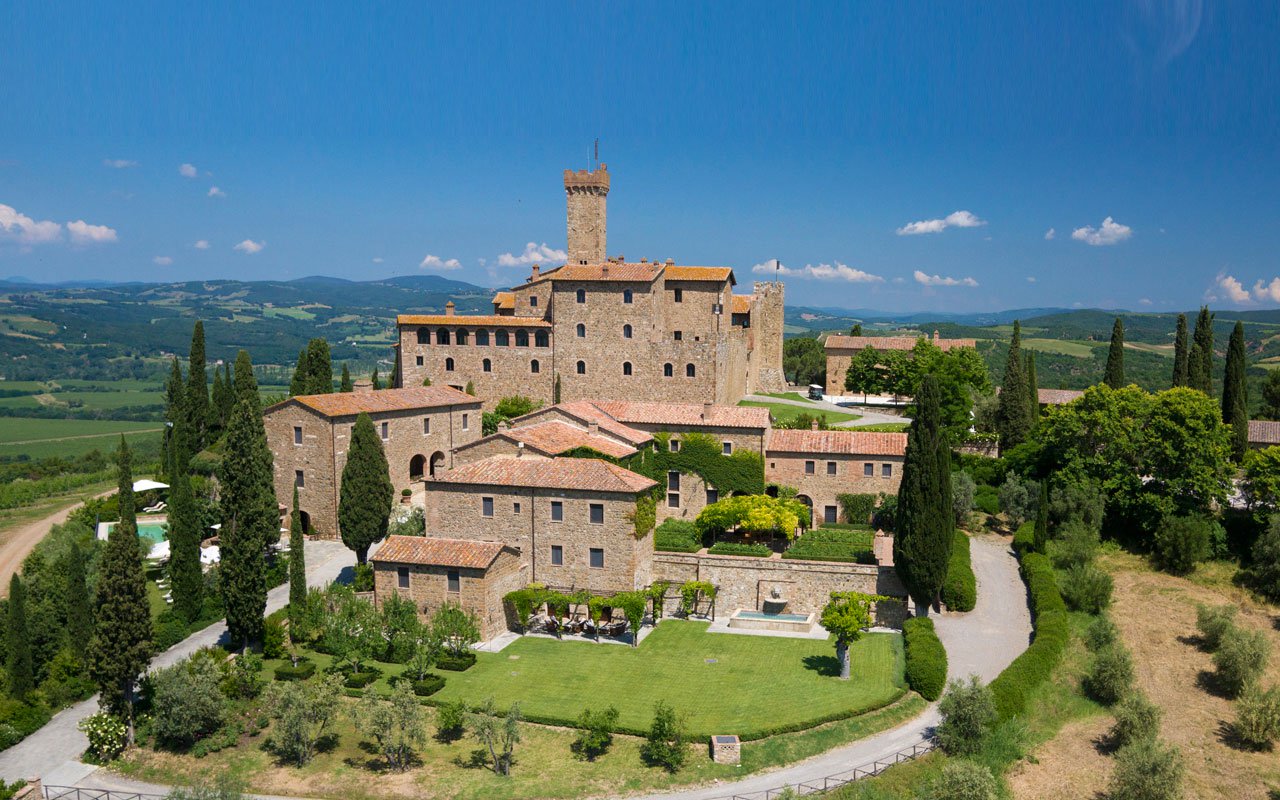 Wine is a joy year-round but
in cooler weather one
grape varietal has really taken center stage in
my daily activities – that most Italian of
grapes, Sangiovese, and its ultimate expression
– Brunello di Montalcino.
Wine is a joy year-round but
in cooler weather one
grape varietal has really taken center stage in
my daily activities – that most Italian of
grapes, Sangiovese, and its ultimate expression
– Brunello di Montalcino.
From mid-September through mid-October,
the Sangiovese grown for our various styles of red
wines are be harvested, culminating with the top
selection for Brunello di Montalcino.
Second, cooler weather here means
it is time to start enjoying more red wines and
especially Sangiovese based wines. That
includes Banfi’s cru of Brunello, Poggio alle Mura,
literally the cream of the crop of our Sangiovese
vineyards. Alongside our Poggio alle Mura Brunello di
Montalcino, this year we introduced two more wines
from the cru Poggio alle Mura – a Rosso di Montalcino
and a Riserva of Brunello. Rosso is sort of like the
younger brother of Brunello, also made from 100%
Sangiovese grapes but usually a selection from younger
vines and the wine is aged only two years compared to
the four required for Brunello. The
Riserva, on the other hand, is an even more selective
harvest of Sangiovese, and ages for an additional year
before release.
What is so special about this cru
Poggio alle Mura?
Well, it is the result our over 30 years of
ongoing research at my family’s vineyard estate,
Castello Banfi.
When we first began planting our vines there in
the late 1970s studies from the University of Bordeaux
indicated which strains of many varietals we should
plant, based on the soil type and microclimate of each
vineyard. But
when it came to the region’s native Sangiovese, there
was only local lore, no scientific research. So we took
it upon ourselves to figure out this vine, and set off
on three decades of incredibly detailed research.
We started
with 600 apparent variations on Sangiovese, because it
is so susceptible to variations in weather and soil,
and narrowed that down to 160 truly genetically
different clones.
We planted a vineyard with two rows of each
type, made wine from each of them, and charted the
differences – remember, you only get one chance a year
to make wine, so this took time.
It took about ten years to get some
concrete results, though we continue to experiment
today and always will – you never stop learning in
science and nature!
Once we determined which were the best,
complementary clones that could be planted together to
make the best Brunello, we chose to plant them in what
we determined to be the optimal vineyard sites. Coincidentally,
the best soils and climate conditions are in the
slopes surrounding the medieval fortress today known
as Castello Banfi, known since Etruscan times as
Poggio alle Mura – the walled hilltop. Hence the
name of our most special “cru” of Brunello,
representing a synthesis between tradition and
innovation.
Though the focus of this study was
our Brunello, all of our Sangiovese-based wines,
including the super Tuscans SummuS, Cum Laude, and
Centine, benefitted from this work. And that’s
the third reason for celebrating Sangiovese this
month, for the range of wonderful reds that usher us
into autumn! One
wine in particular was inspired by our research – the
BelnerO, a Sangiovese dominant blend with what I like
to call a kiss of Cabernet and a whisper of Merlot. We grow the
grapes a little differently for BelnerO than for
Brunello, make the wine with less oak aging and
released it earlier from the winery, providing a
counterpoint to Brunello and a lovely terroir-driven
wine in its own right.
If you
know Italians, you know that by nature we are
multi-faceted, varying in mood, and always passionate. As a
nation, we span from the hot sunny beaches of Sicily
near the African coast to the rugged mountains and
Alpine ski slopes of Trentino-Alto Adige in the north. Sangiovese
is grown in almost all of Italy’s regions and reflects
the unique nature of each; it is most famous
(rightfully so) in Tuscany, yet even there it reflects
the nuances of each hilltop, valley and subzone. It has
something a little different to say in Brunello than
Chianti, Morellino than Vino Nobile di Montepulciano,
Rosso di Montalcino than Super Tuscan blends.
Here is a smattering of
Sangiovese-based wines that you may wish to get to
know better, reflecting a spectrum that appeals to
every occasion, every taste, and every budget. We can
assure you that the conversation will never become
boring. 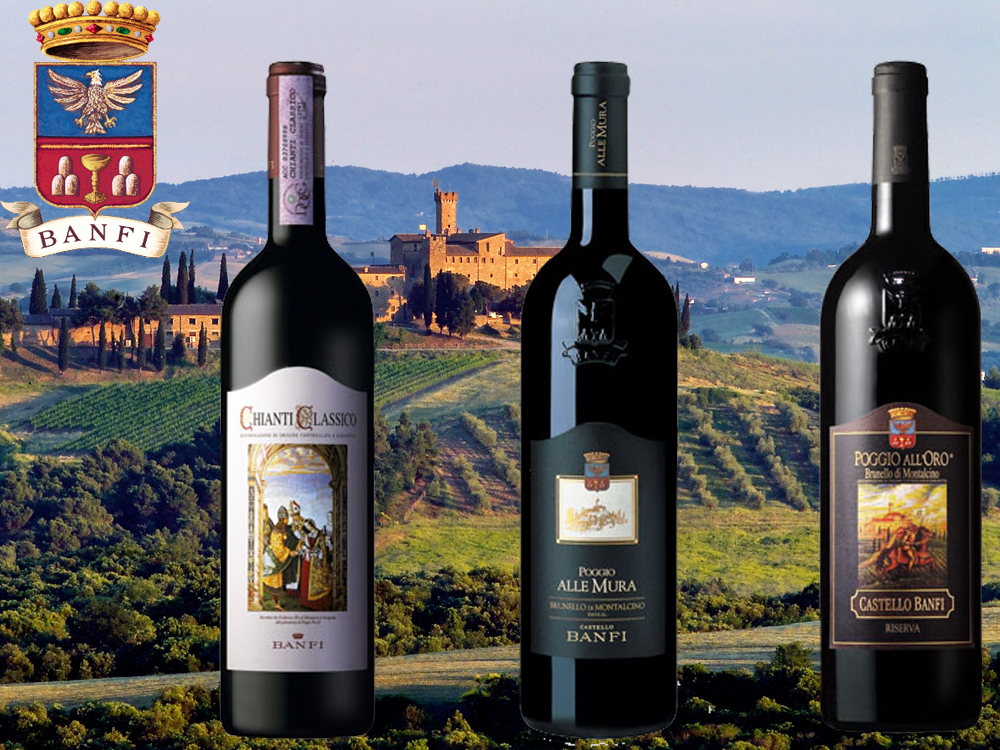
Recommendations for Celebrating
Sangiovese
BelnerO Proprietor’s Reserve Sangiovese
– A refined
cuvée of noble red grapes perfected by our pioneering
clonal research. This dark beauty, BelnerO, is
produced at our innovative winery, chosen 11
consecutive years as Italy’s Premier Vineyard Estate.
Fermented in our patented temperature controlled
French oak and aged approximately 2 additional years.
Unfiltered, and Nitrogen bottled to minimize sulfites.
Castello Banfi Brunello di Montalcino –
Rich, round, velvety and intensely
aromatic, with flavor hints of licorice, cherry, and
spices. Brunello di Montalcino possesses an intense
ruby-red color, and a depth, complexity and opulence
that is softened by an elegant, lingering aftertaste.
Unfiltered after 1998 vintage.
Castello Banfi Rosso di Montalcino – Brunello's "younger brother," produced
from select Sangiovese grapes and aged in barrique for
10 to 12 months. Deep ruby-red, elegant, vibrant,
well-balanced and stylish with a dry velvety
finish.
Poggio all’Oro Brunello di Montalcino
Riserva – A single vineyard selection of our most
historically outstanding Sangiovese, aged five years
before release, the additional year more than that
required of Brunello including 6 months in barrel and
6 months more in bottle to grant its “Riserva”
designation. Incredible
elegance and harmony. Intense with lots of fruit and
subtle wood influence. Round, complete, well balanced
with hints of chocolate and berries. Unfiltered after
1998.
Poggio alle Mura – The first tangible result of years of
intensive clonal research on Montalcino’s native
Sangiovese grape.
Estate bottled from the splendidly sun drenched
vineyards surrounding the medieval Castello from which
it takes its name.
The Brunello
di Montalcino is seductive, silky and smoky. Deep ruby
in color with an expressive bouquet of violets, fruits
and berries as well as cigar box, cedar and exotic
spices. The Rosso
di Montalcino is also intense ruby red. The bouquet
is fresh and fruity with typical varietal notes of
cherry and blackberry, enriched by more complex hints
of licorice, tobacco and hazelnut. It is full
bodied, yet with a soft structure, and a surprisingly
long finish. The Poggio alle Mura Brunello di Montalcino
Riserva is deep ruby red with garnet
reflections and a rich, ample bouquet that hints of
prune jam, coffee, cacao and a light balsamic note. It is full
and powerful, with ripe and gentle tannins that make
it velvety and harmonious; this wine is supported by a
pleasing minerality that to me speaks soundly of that
special hillside in southern Montalcino.
SummuS – A wine of towering elegance, SummuS is an
extraordinary blend of Sangiovese which contributes
body; Cabernet Sauvignon for fruit and structure; and
Syrah for elegance, character and a fruity bouquet. An elegant,
complex and harmonious red wine.
Cum Laude – A complex and elegant red which graduated
“With Honors,” characterized by aromas of juicy
berries and fresh spices.
Centine – A Cuvee that is more than half
Sangiovese, the balanced consisting of equal parts of
Cabernet Sauvignon and Merlot. Vinified in
a firm, round style that easily accompanies a wide
range of dishes, this is a smooth and fragrantly
satisfying wine with international character, and a
perennial favorite at my own dinner table.
Banfi Chianti Superiore – The “Superiore” designation signifies
stricter government regulations regarding production
and aging requirements, as compared to regular
Chianti. An
intense ruby red wine with fruit forward aromas and
floral notes. This
is a round wine with well-balanced acidity and fruit.
Banfi Chianti Classico – An enduring classic: alluring
bouquet of black fruit and violets; rich flavors of
cherry and leather; supple tannins and good acidity
for dining.
Banfi Chianti Classico Riserva – Produced from select grapes grown in the
"Classico" region of Chianti, this dry, fruity and
well-balanced red has a full bouquet reminiscent of
violets.
Fonte alla Selva Chianti Classico – This is our newest entry into the Chianti
arena, coming from a 99 acre estate in Castellina, the
heart of the Chianti Classico region. The wine is
a captivating mauve red that smells of cherry, plum
and blackberry with hints of spice. It is
round, full and balanced with very good
acidity.
Col di Sasso – Sangiovese and Cabernet Sauvignon. Luscious,
complex and soft with persistent notes of fruit and
great Italian style structure.
Any of John Mariani's books below may be ordered from amazon.com.
 The Hound in Heaven
(21st Century Lion Books) is a novella, and
for anyone who loves dogs, Christmas, romance,
inspiration, even the supernatural, I hope you'll find
this to be a treasured favorite. The story
concerns how, after a New England teacher, his wife and
their two daughters adopt a stray puppy found in their
barn in northern Maine, their lives seem full of promise.
But when tragedy strikes, their wonderful dog Lazarus and
the spirit of Christmas are the only things that may bring
his master back from the edge of despair.
The Hound in Heaven
(21st Century Lion Books) is a novella, and
for anyone who loves dogs, Christmas, romance,
inspiration, even the supernatural, I hope you'll find
this to be a treasured favorite. The story
concerns how, after a New England teacher, his wife and
their two daughters adopt a stray puppy found in their
barn in northern Maine, their lives seem full of promise.
But when tragedy strikes, their wonderful dog Lazarus and
the spirit of Christmas are the only things that may bring
his master back from the edge of despair. WATCH THE VIDEO!
“What a huge surprise turn this story took! I was completely stunned! I truly enjoyed this book and its message.” – Actress Ali MacGraw
“He had me at Page One. The amount of heart, human insight, soul searching, and deft literary strength that John Mariani pours into this airtight novella is vertigo-inducing. Perhaps ‘wow’ would be the best comment.” – James Dalessandro, author of Bohemian Heart and 1906.
“John Mariani’s Hound in Heaven starts with a well-painted portrayal of an American family, along with the requisite dog. A surprise event flips the action of the novel and captures us for a voyage leading to a hopeful and heart-warming message. A page turning, one sitting read, it’s the perfect antidote for the winter and promotion of holiday celebration.” – Ann Pearlman, author of The Christmas Cookie Club and A Gift for my Sister.
“John Mariani’s concise, achingly beautiful novella pulls a literary rabbit out of a hat – a mash-up of the cosmic and the intimate, the tragic and the heart-warming – a Christmas tale for all ages, and all faiths. Read it to your children, read it to yourself… but read it. Early and often. Highly recommended.” – Jay Bonansinga, New York Times bestselling author of Pinkerton’s War, The Sinking of The Eastland, and The Walking Dead: The Road To Woodbury.
“Amazing things happen when you open your heart to an animal. The Hound in Heaven delivers a powerful story of healing that is forged in the spiritual relationship between a man and his best friend. The book brings a message of hope that can enrich our images of family, love, and loss.” – Dr. Barbara Royal, author of The Royal Treatment.
 |
The Encyclopedia of American Food and Drink by John F. Mariani (Bloomsbury USA, $35) Modesty forbids me to praise my own new book, but let me proudly say that it is an extensive revision of the 4th edition that appeared more than a decade ago, before locavores, molecular cuisine, modernist cuisine, the Food Network and so much more, now included. Word origins have been completely updated, as have per capita consumption and production stats. Most important, for the first time since publication in the 1980s, the book includes more than 100 biographies of Americans who have changed the way we cook, eat and drink -- from Fannie Farmer and Julia Child to Robert Mondavi and Thomas Keller. "This book is amazing! It has entries for everything from `abalone' to `zwieback,' plus more than 500 recipes for classic American dishes and drinks."--Devra First, The Boston Globe. "Much needed in any kitchen library."--Bon Appetit. |
"Eating Italian will never be the same after reading John Mariani's entertaining and savory gastronomical history of the cuisine of Italy and how it won over appetites worldwide. . . . This book is such a tasteful narrative that it will literally make you hungry for Italian food and arouse your appetite for gastronomical history."--Don Oldenburg, USA Today. "Italian
restaurants--some good, some glitzy--far
outnumber their French rivals. Many of
these establishments are zestfully described
in How Italian Food Conquered the World, an
entertaining and fact-filled chronicle by
food-and-wine correspondent John F.
Mariani."--Aram Bakshian Jr., Wall Street
Journal.
"Equal parts
history, sociology, gastronomy, and just
plain fun, How Italian Food Conquered the
World tells the captivating and delicious
story of the (let's face it) everybody's
favorite cuisine with clarity, verve and
more than one surprise."--Colman Andrews,
editorial director of The Daily
Meal.com. "A fantastic and fascinating
read, covering everything from the influence
of Venice's spice trade to the impact of
Italian immigrants in America and the
evolution of alta cucina. This book will
serve as a terrific resource to anyone
interested in the real story of Italian
food."--Mary Ann Esposito, host of PBS-TV's
Ciao
Italia. "John Mariani has written the
definitive history of how Italians won their
way into our hearts, minds, and
stomachs. It's a story of pleasure over
pomp and taste over technique."--Danny Meyer,
owner of NYC restaurants Union Square
Cafe, The Modern, and Maialino.
|
 |
 |
 |
 |
 |
 |
 |
 |
 Everett Potter's Travel Report:
Everett Potter's Travel Report: 
 Eating Las Vegas
JOHN CURTAS has been covering the Las Vegas
food and restaurant scene since 1995. He is
the co-author of EATING LAS VEGAS – The 50
Essential Restaurants (as well as
the author of the Eating Las Vegas web site: www.eatinglasvegas.
He can also be seen every Friday morning as
the “resident foodie” for Wake Up With the
Wagners on KSNV TV (NBC) Channel 3 in
Las Vegas.
Eating Las Vegas
JOHN CURTAS has been covering the Las Vegas
food and restaurant scene since 1995. He is
the co-author of EATING LAS VEGAS – The 50
Essential Restaurants (as well as
the author of the Eating Las Vegas web site: www.eatinglasvegas.
He can also be seen every Friday morning as
the “resident foodie” for Wake Up With the
Wagners on KSNV TV (NBC) Channel 3 in
Las Vegas.
MARIANI'S VIRTUAL GOURMET
NEWSLETTER is published weekly. Publisher: John Mariani. Editor: Walter Bagley. Contributing Writers: Christopher Mariani,
Robert Mariani, Misha Mariani, John A. Curtas, Gerry Dawes, Geoff Kalish,
and Brian Freedman. Contributing
Photographer: Galina Dargery. Technical
Advisor: Gerry
McLoughlin.
If you wish to subscribe to this
newsletter, please click here: http://www.johnmariani.com/subscribe/index.html
© copyright John Mariani 2017

